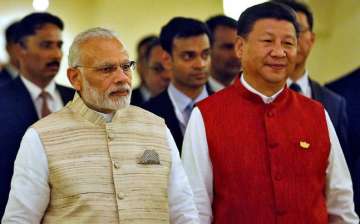India-China summit at Mamallapuram set to refesh town's link with China
The mighty Pallavas, whose flourishing sea port was Mamallapuram for a long time, had a relationship with China and had even sent envoys there during their rule.

While the expectation is in the air in view of the Indo-China meet near here next week, Mamallapuram's ties with the dragon land are ancient and it is set to give a historic fillip to the summit.
The mighty Pallavas, whose flourishing seaport was Mamallapuram for a long time, had a relationship with China and had even sent envoys there during their rule.
As preparations are on the upswing for the meet between Prime Minister Narendra Modi and Chinese President Xi Jinping, a peep into archaeological evidences shows links had existed about 2000 years ago between Mamallapuram, the venue of the summit, and China.
"Celadon ware (pottery) of the first, second century (Common Era, about 2000 years ago) recovered on the eastern coast of Tamil Nadu gives us a clue to Chinese maritime activities," noted archaeologist S Rajavelu told PTI.
Such finds and other archaeological evidences can be used to infer that regions, including coastal areas of present-day Mamallapuram and Kancheepuram district had links with China, he said.
Chinese coins dating to the same period were also found in Tamil Nadu, he said, adding they showed the ancient trade links to the dragon country.
The ancient Tamil work "Pattinapalai," a post-Sangam period work, cites the anchorage of a Chinese ship on the eastern coast of ancient Tamil Nadu.
Authored by Urutthiran Kannanar, the work refers to a ship "tungu naavay," in Tamil, which is nothing but a big Chinese vessel "Zunk," the archaeologist, who was formerly with the Archaeological Survey of India, said.
Also the Chinese text the "Han annals" has a reference to contacts with the Tamil country.
Emperor Wei (circa 185-149 BCE) encouraged traders and the Chinese text Ch'ien Han Shu of the first century refers to Kancheepuram as "Huang-Che" and Chinese kings had sent presents to the then ruler of Kancheepuram, he pointed out.
"If you look at the Vayalur inscriptions (near Mamallapuram), they say that Pallavas had sent envoys (6-7th Century AD) to China. Similarly Tamil inscriptions have been found in the dragon country as well," Rajavelu, also a former Professor of Archaeology with the Tamil University at Thanjavur, said.
Chinese monk Hiuen Tsang visited Kancheepuram in the seventh Century AD and he no doubts reached the ancient port town of Mamallapuram and then continued his journey to the temple town, he said.
Keen on understanding more about Buddhism and to get original texts of his religion, Hiuen Tsang visited Kancheepuram, which was then a flourishing Buddhist centre, as well as a hub of learning, he said.
Ancient Indian sources indicate that Kancheepuram was referred to as a "kadiga," which meant a "university," and Tsang was attracted to Kancheepuram, the professor of archaeology, now working with Alagappa University, said.
The 2004 Saluvankuppam excavations in Kancheepuram district also make it clear that Mamallapuram was a port town even during the Sangam era about 2000 years ago, he pointed out.
The second informal summit between the two leaders will be held this week at Mamallapuram.
ALSO READ | Modi-Jinping summit as significant as 1988 Rajiv Gandhi-Deng Xiaoping meet, says Chinese official media
ALSO READ | Tibetans stage protest outside Taj Palace over Xi's India visit